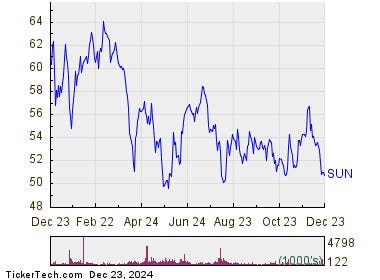Warren Buffett’s renowned investment philosophy emphasizes capitalizing on market sentiment extremes. He advocates buying when others are fearful and selling when others are greedy, a contrarian approach that exploits market inefficiencies driven by emotional responses. One tool to gauge market fear surrounding a particular stock is the Relative Strength Index (RSI), a momentum oscillator that fluctuates between 0 and 100. An RSI reading below 30 typically suggests an oversold condition, indicating that the stock price may have fallen too far too fast and could be poised for a rebound. This doesn’t guarantee a price reversal, but it flags a potential buying opportunity for investors seeking undervalued assets. Identifying oversold stocks allows investors to potentially buy low, capitalizing on fear-driven selling pressure and positioning themselves for future price appreciation.
The case of Sunoco (SUN) on Monday illustrates this concept. The stock’s price dipped to $49.62 per share, pushing its RSI to 29.9, below the 30 threshold and firmly into oversold territory. This contrasted with the broader market, as represented by the S&P 500 ETF (SPY), which maintained a healthier RSI of 43.6. For bullish investors, SUN’s oversold condition signaled a potential buying opportunity. The sharp decline in price, reflected in the low RSI, suggests that selling pressure might be waning, creating a possible entry point for those anticipating a price recovery. This doesn’t guarantee a turnaround, but it highlights a situation where the stock might be undervalued due to excessive negativity.
Analyzing SUN’s one-year performance provides further context. Its 52-week range spans from a low of $49.45 to a high of $64.89. The Monday closing price of $50.22 places it near the bottom of this range, reinforcing the notion of a potential undervaluation. The significant price drop from its 52-week high suggests that considerable selling pressure has already occurred. Coupled with the oversold RSI, this scenario could attract investors seeking value opportunities, anticipating a price rebound towards the higher end of the 52-week range.
It is crucial to remember that technical indicators like RSI are not foolproof predictors. While an oversold RSI suggests a potential buying opportunity, it doesn’t guarantee a price reversal. Other factors, such as fundamental analysis of the company’s financial health and the overall market environment, are essential considerations before making investment decisions. Relying solely on technical indicators can be misleading and risky. A comprehensive investment strategy should integrate both technical and fundamental analysis to gain a more complete picture of the stock’s potential.
Moreover, understanding the concept of “mean reversion” is crucial when interpreting RSI. The idea is that prices tend to fluctuate around a mean or average value. When prices deviate significantly from this mean, as in an oversold or overbought condition, they are likely to revert back towards it over time. This principle underlies the use of RSI as a trading signal. However, the timing and extent of mean reversion are uncertain, and relying solely on this principle can be risky. It’s essential to combine RSI with other indicators and fundamental analysis to improve the accuracy of trading decisions.
Finally, interpreting RSI within the context of market trends is vital. During a sustained downtrend, a stock can remain oversold for extended periods as selling pressure persists. Conversely, in a strong uptrend, a stock might remain overbought for some time as buying momentum continues. Therefore, it’s important to consider the overall market direction and the stock’s specific trend when using RSI. A bearish market environment might warrant caution even if a stock appears oversold, while a bullish market could strengthen the case for buying an oversold stock. Integrating RSI with broader market analysis and trend identification provides a more informed perspective for investment decisions.

